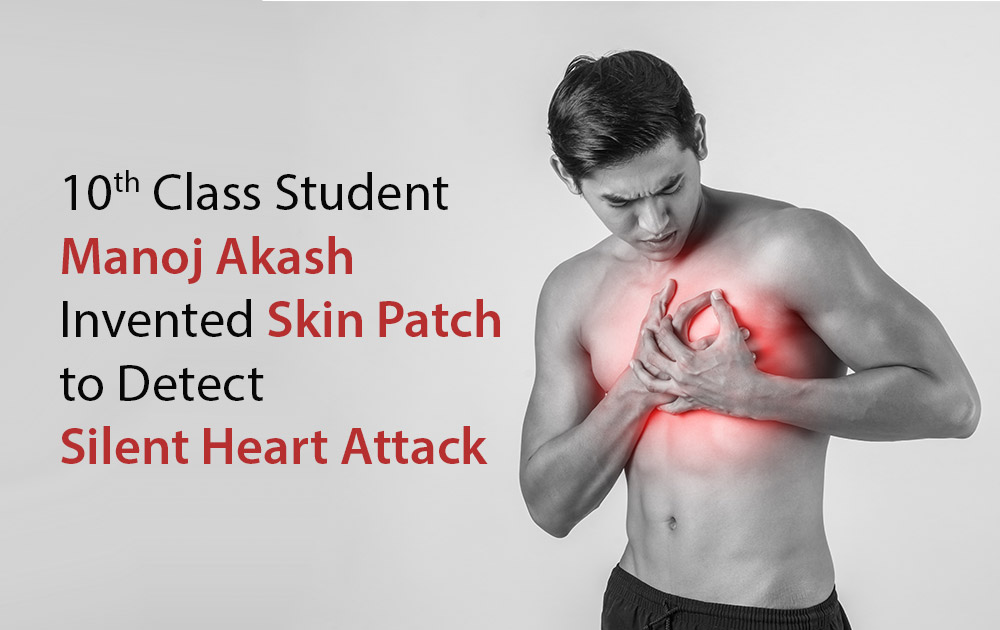The death of his grandfather due to heart attack led Manoj Akash, a class 10th student of Ashok Leyland School in Hosur, Karnataka, to invent skin patch which has to be attached to the wrist or the back of the ear and it will release a small ‘positive’ electrical impulse, which will attract the negatively charged protein released by the heart to signal a heart attack. If the quantity of this protein – FABP3 — is high, the person must seek immediate medical attention.
Since class eight he started visiting the library of the Indian Institute of Science in Bengaluru – an hour away from his hometown. He could not afford expensive books and journals. Only option left to visit library for this enterprising adolescent who had an extra knack to comprehend complexities of cardiology just because of his penchant for the heart diseases studies. He was chosen for the President’s Innovation Scholar’s In-Residence Programme at Rashtrapati Bhavan.
The 16-year-old says that he investigated a novel concept that could potentially allow patients to detect silent heart attacks by non-invasively sensing the FABP3 biomarker in the bloodstream. ABP3 is a lightweight protein, releases quickly from heart muscle into the bloodstream during a heart attack, and therefore, it is an optimal cardiac diagnostic marker.
According to him, doctors may test a patient’s blood for FABP3. If he or she experiences characteristic symptoms like chest pain. However, not all heart attacks make themselves known through easily noticeable signs. Silent heart attacks, which are becoming increasingly common, are asymptomatic, making them more dangerous than conventional heart attacks.
Patients often “drop dead” while feeling completely normal. This collapse happened to my grandfather on July 3rd, 2015 which served as an impetus for me to find a solution to this problem. In these “silent” cases, doctors are unlikely to administer the crucial FABP3 blood test because there is no visible presentation of symptoms to warrant a diagnostic test. As a result, silent heart attacks go unnoticed.
“I realized that if at-risk patients could test themselves daily for the presence of FABP3 in their blood. They would have higher chances of detecting silent heart attacks as they occur. A method that allows daily self-testing would have to be non-invasive, safe, and easy to use. Ultimately, it would have to involve a transcutaneous blood analysis, which examines the contents of one’s blood without penetrating the skin.
In searching for ways to tackle this challenging prospect. I examined the various distinguishing characteristics of blood proteins that would allow them to be identified transcutaneously. I found that proteins have distinctive masses and electric charges in blood.
So, I used a model to test whether different magnitudes of charged electricity. When applied to a thin area of skin, would isolate FABP3 from the other blood proteins and attract FABP3 to the capillary walls. My results showed that this is true.
This means that the technique that I investigated can potentially be coupled with transcutaneous UV-protein quantification to non-invasively measure the amount of FABP3 in a patient’s blood and alert him or her of a silent heart attack.”
Help Million Hearts Stay Healthy! Is his web page that narrates his vision.
He was frequenting scientific conventions to further his knowledge in the science field. Internet gave him a lot of insight, he admits Clinical trials for the medical device are on. And it could be approved for a human trial. The product would be fit to be launched in the market after two months of human trial, assuming nothing goes wrong.
“I have already filed for a patent and I would tie up with the department of biotechnology for the trial. I would want the Government of India to take the project instead of selling it to a private company because it is for the public good,” he says on his website.
To monitor, regular use small silicon patch stuck to your wrist or back of your ear. Whether there has been a heart attack instead of waiting for a doctor to prescribe a test.
The patch uses a positively charged electrical impulse to draw negatively charged —protein to the surface; If the amount of FABP3 is high, then the person would need immediate medical attention; Experts recommend to use the device twice a day. The product can soon be in the market. It would cost around R 900, cheaper than a glucometer symptoms at all.
Diabetes, high blood pressure, high cholesterol levels all put you at risk of a silent heart attack, experts say. Having a silent heart attack puts people at a greater risk of having another heart attack, which could be fatal. Having another heart attack also increases the risk of complications, such as heart failure.
Chest pain, pain in the left arm or shortness is when of breath characterizes a silent heart attack. A silent heart attack may not show symptoms of chest pain and shortness of breath that doesn’t feel heart attack. Akash aims to study cardiology at the country’s premier All India Institute of Medical Sciences in Delhi.
Want to write for InnoHEALTH? send us your article at magazine@innovatiocuris.com


From what source is purchase possible?